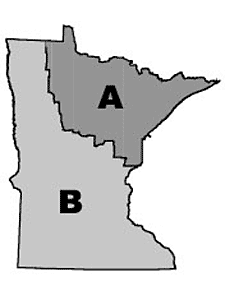 |
| Minnesota's wolves were delisted in January |
The wolf hunt was approved by the Minnesota Legislature in its most recent session, shortly after the Minnesota, Wisconsin, and Michigan wolf populations were removed from the federal endangered species list in January.
According to the management plan as it was written in 2001, no hunting would be done for five years following delisting. This restriction, however, was waived in a rider attached to a budget bill passed by the state legislature shortly after the delisting of the wolves.
Six thousand licenses will be issued for the hunt, according to DNR plans, though the hunt will be closed once the quota of 400 animals have been killed. Over 23,000 people have applied for a permit, with applications from 33 states, though the majority have been from Minnesota.
The Center for Biological Diversity and Howling for Wolves argue that the 30-day online survey by DNR this summer did not give the public a fair chance to try to shape the regulations, in part because many rural residents lack reliable internet access. The complaint by the groups claims that while the expedited emergency review process the DNR used is legal for some situations, it is not appropriate for the wolf hunt decision.
"There's nothing in the Minnesota law that says an online survey can substitute for formal notice and comment on rulemaking by the agency," said Collette Adkins Giese, an attorney for the center. “Especially considering the tremendous controversy around hunting and trapping of Minnesota’s wolves, state officials should have followed the law carefully to make sure they fully understood how the public felt about their decision.”
Of the 7,351 people who did respond to the online survey offered by the DNR, over 75 percent opposed the wolf hunt, with only 1,542 responses in support.
The groups say that the DNR could have waited until fall 2013 or later to open a wolf hunt, so that the public would have more time to weigh in. They further argue that the hunt would deprive citizens the opportunity to see and hear the wolves, and would disrupt ecosystems by reducing the presence of top predators. They say that their members are distressed by the thought of wolves being killed or injured, and by the possibility that they might witness dead or suffering wolves.
The DNR has not yet had time to review the lawsuit, said DNR spokesperson Chris Niskanen. The agency has no official comment yet.
 |
| Expansion of wolf range |
The Minnesota wolf population received no protections until 1973, when it was placed on the federal endangered species list. By that point, a few hundred individuals in the northern forests were the only remnant of the species in the lower forty-eight states, all of which were once inhabited by the wolf.
After the wolf was given protections, the hunting and trapping of wolves was banned, with the exception of operations to to remove wolves which were believed to be killing livestock.
Under federal protection, the Minnesota wolf population expanded, filling a large part of the state's northern conifer forests. Minnesota currently has the largest wolf population of the lower 48 states, at an estimated 3,000 animals.
The wolf was delisted in 2011, after the DNR petitioned the federal government in 2010 to hand over responsibility for the wolves. The change of management was further supported by petitions by the US Sportsmen's Alliance, Safari Club International, the National Rifle Association.
 |
| The two management zones |
“The DNR recognizes there is a wide range of opinions toward wolf hunting and trapping, but all Minnesotans should know the DNR’s primary wolf management goal is to ensure the long-term survival of the wolf. The DNR’s conservative approach to this first season is based on sound conservation science and principles.” said DNR Commissioner Tom Landwehr.
Wolf advocates remain unconvinced. “Wolves already die at high rates from many causes, including human intolerance and persecution,” said Howling for Wolves president and founder Maureen Hacket, “Minnesotans benefit economically, culturally and ecologically by having wolves in the wild. As a state, we have so much to gain by keeping wolves undisturbed.”
Image Sources: Center for Biological Diversity, MPR, Wolves of the World
Update: October 3- The state has officially requested that the court not block the hunt, saying that the case lacks legal merit.
No comments:
Post a Comment